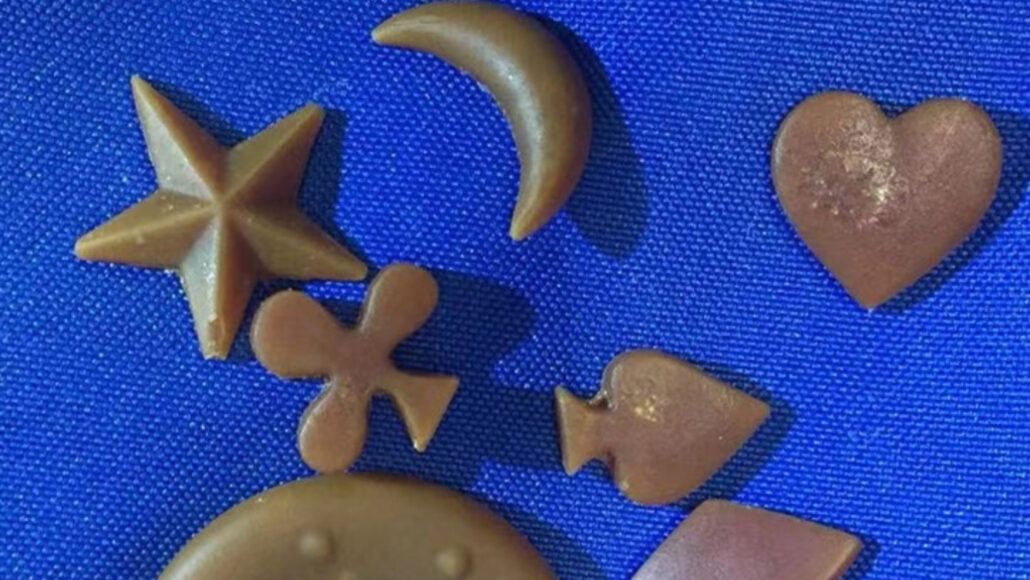alkaline: An adjective that describes a chemical that produces hydroxide ions (OH-) in a solution. These solutions are also referred to as basic — as in the opposite of acidic — and have a pH above 7.
atom: The basic unit of a chemical element. Atoms are made up of a dense nucleus that contains positively charged protons and uncharged neutrons. The nucleus is orbited by a cloud of negatively charged electrons.
carbon: A chemical element that is the physical basis of all life on Earth. Carbon exists freely as graphite and diamond. It is an important part of coal, limestone and petroleum, and is capable of self-bonding, chemically, to form an enormous number of chemically, biologically and commercially important molecules.
chemical: A substance formed from two or more atoms that unite (bond) in a fixed proportion and structure. For example, water is a chemical made when two hydrogen atoms bond to one oxygen atom. Its chemical formula is H2O.
condense: To become thicker, denser or to distill out the essence of something. This can occur, for instance, when moisture evaporates out of a liquid. Condense also can mean to change from a gas or a vapor into a liquid.
crude oil: Petroleum in the form as it comes out of the ground.
detergent: A compound derived from petroleum products, often used for cleaning. Detergents work by breaking up and surrounding dirt particles or oily substances, so that they can be washed away with water.
environment: The sum of all of the things that exist around some organism or the process and the condition those things create. Environment may refer to the weather and ecosystem in which some animal lives, or, perhaps, the temperature and humidity (or even the placement of things in the vicinity of an item of interest).
green: (in chemistry and environmental science) An adjective to describe products and processes that will pose little or no harm to living things or the environment.
landfill: A site where trash is dumped and then covered with dirt to reduce smells. If they are not lined with impermeable materials, rains washing through these waste sites can leach out toxic materials and carry them downstream or into groundwater. Because trash in these facilities is covered by dirt, the wastes do not get ready access to sunlight and microbes to aid in their breakdown. As a result, even newspaper sent to a landfill may resist breakdown for many decades.
literally: An adjective indicating that the phrase it modifies is precisely true. For instance, to say: "It's so cold that I'm literally dying," means that this person actually expects to soon be dead, the result of getting too cold.
lubricant: A substance used to cut friction between surfaces that are in contact with one another.
mass: A number that shows how much an object resists speeding up and slowing down — basically a measure of how much matter that object is made from.
oxygen: A gas that makes up about 21 percent of Earth's atmosphere. All animals and many microorganisms need oxygen to fuel their growth (and metabolism).
plastic: Any of a series of materials that are easily deformable; or synthetic materials that have been made from polymers (long strings of some building-block molecule) that tend to be lightweight, inexpensive and resistant to degradation. (adj.) A material that is able to adapt by changing shape or possibly even changing its function.
polyethylene: A plastic made from chemicals that have been refined (produced from) crude oil and/or natural gas. The most common plastic in the world, it is flexible and tough. It also can resist radiation.
polypropylene: The second most common plastic in the world. It is tough and durable. Polypropylene is used in packaging, clothing and furniture (such as plastic chairs).
raw materials: The natural products and unfinished goods used to manufacture other things. These can range from minerals such as iron, coal and silica to farmed products such as cotton and oats. They can even include some processed ingredients, such as lumber, gasoline, plastics, solvents and adhesives.
solution: A liquid in which one chemical has been dissolved into another.
surfactant: A chemical that decreases the attraction between water molecules. Manufacturers use such compounds to make it easier for water to spread on surfaces and to mix with other substances (such as oil).
trait: A characteristic feature of something.
upcycle: To recycle something in such a way that it transforms the starting material — often a waste — into something of higher value. For instance, the new material might substitute for more polluting or harmful raw materials.
waste: Any materials that are left over from biological or other systems that have no value, so they can be disposed of as trash or recycled for some new use.








